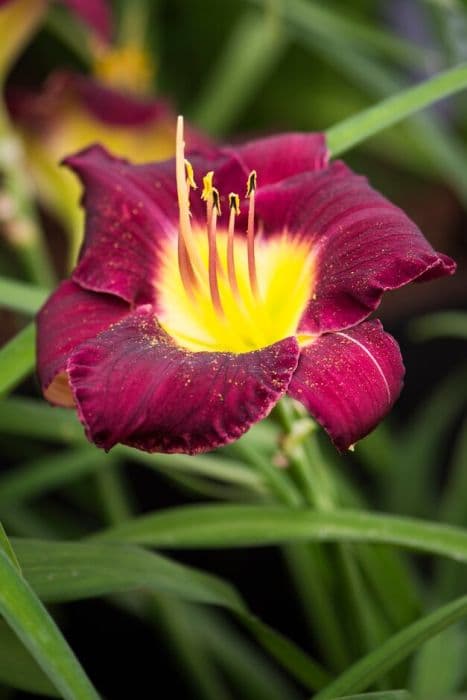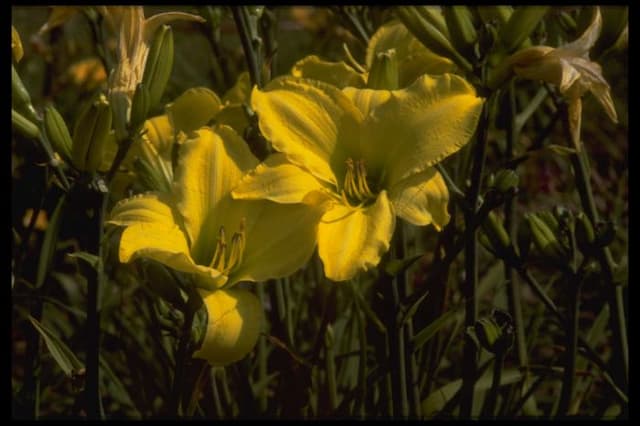Daylily Hemerocallis 'Royal Mountie'

ABOUT
Hemerocallis 'Royal Mountie', commonly known as the Daylily, is a perennial plant known for its vibrant, showy flowers. The flowers of the Royal Mountie are typically a rich, deep red hue that can bring a dramatic flair to any garden. These blossoms may feature a velvety texture and can have a trumpet-like form, often with ruffled or slightly recurved edges that add to their ornamental appeal. Each bloom consists of three petals and three sepals, which together give the appearance of a six-part flower. The foliage of the Royal Mountie Daylily forms a lush clump of green, strap-like leaves. These leaves are long and arching, creating a graceful, fountain-like effect. The leaves emerge from a central crown at the base of the plant, which gives the plant a neat and organized appearance even when it is not in bloom. Daylilies are renowned for their ability to produce numerous blossoms during their blooming period. Each Royal Mountie flower only lasts for one day, hence the name "Daylily," but the plant produces many flower buds that open on different days, ensuring an extended and prolific display of color in the garden. Overall, the Royal Mountie Daylily has a captivating and regal presence, with its combination of deep red flowers and lush green foliage, making it a popular choice for garden enthusiasts seeking to add a touch of elegance to their outdoor spaces.
About this plant
 Names
NamesFamily
Hemerocallidaceae
Synonyms
Daylily
Common names
Hemerocallis 'Royal Mountie'.
 Characteristics
CharacteristicsLife cycle
Perennials
Foliage type
Deciduous
Color of leaves
Green
Flower color
Red
Height
2 feet 24 inches (60 cm)
Spread
2 feet 24 inches (60 cm)
Plant type
Herb
Hardiness zones
3
Native area
Asia
Benefits
 General Benefits
General Benefits- Easy to Grow: Hemerocallis 'Royal Mountie', commonly known as daylily, is known for being a low-maintenance and easy-to-grow perennial.
- Drought Tolerant: Once established, daylilies are quite drought tolerant, making them suitable for gardens in drier climates.
- Pest Resistant: Daylilies are generally resistant to pests, reducing the need for chemical interventions.
- Versatile: They can thrive in a variety of soil types and conditions, from full sun to part shade.
- Long Blooming: The daylily has a long blooming period, providing color and visual interest throughout the growing season.
- Attracts Pollinators: Daylilies attract butterflies and bees, bringing beneficial pollinators to the garden.
- Erosion Control: Their root system can help stabilize soil and prevent erosion on slopes and in areas prone to soil loss.
- Edible: Some parts of daylilies are edible, and they can be used in salads or as garnishes, contributing to culinary uses.
- Wide Variety of Colors: They come in a range of colors and patterns, which can complement any garden design.
- Dividable: Daylilies can be easily divided to create more plants, making them economical and great for sharing with fellow gardeners.
 Medical Properties
Medical PropertiesThis plant is not used for medical purposes.
 Air-purifying Qualities
Air-purifying QualitiesThis plant is not specifically known for air purifying qualities.
 Other Uses
Other Uses- The flowers of the daylily 'Royal Mountie' can be used as a natural dye for fabrics, imparting a range of soft yellow to green hues depending on the mordant used.
- The sturdy foliage can serve as a subtle privacy screen in the garden when planted in a dense row.
- The blooms can be pressed and included in decorative crafts such as bookmarks or greeting cards for a touch of nature.
- Daylily buds are sometimes pickled as a unique culinary treat, offering a crunchy texture and a mild, slightly sweet flavor.
- Fibers from daylily leaves can be used in the creation of natural twine or rope with a rustic appearance.
- The plant can act as a natural pest deterrent; when planted strategically, it may help to keep certain types of insects away from more vulnerable garden plants.
- Dried daylily petals can be incorporated into potpourri mixes for a subtle fragrance and attractive addition to the mix.
- The daylily 'Royal Mountie' can be used in companion planting to attract pollinators such as bees and butterflies to the garden, benefitting other plants nearby.
- The strong root system of the daylily can be utilized for erosion control on slopes or areas susceptible to soil erosion.
- As part of a rain garden, daylilies can help in managing stormwater runoff and filtering pollutants from the water as it soaks into the ground.
Interesting Facts
 Feng Shui
Feng ShuiThe Daylily is not typically used in Feng Shui practice.
 Zodiac Sign Compitability
Zodiac Sign CompitabilityThe Daylily is not used in astrology practice.
 Plant Symbolism
Plant Symbolism- Daylilies: Generally symbolize coquetry, flirtation, and sometimes motherhood, as they can represent a mother’s devotion due to the flower's ability to produce a large number of offspring (flowers).
- Transience: The specific name 'Hemerocallis' comes from Greek words meaning "beauty" and "day," suggesting the fleeting nature of life and beauty, as each bloom typically lasts for just one day.
- Renewal and New Opportunities: Since a new flower emerges and replaces the old one each day, daylilies can symbolize renewal, hope, and the seizing of new opportunities.
- Survival and Adaptability: Known for their hardiness and ability to thrive in a variety of conditions, daylilies can represent the ability to withstand challenges and adapt to different situations in life.
 Water
WaterDaylilies, including the 'Royal Mountie', should be watered deeply once a week, providing about 1 inch of water each time, which is roughly 0.6 gallons per square yard of soil. During hot or dry spells, watering frequency should increase to twice per week. Ensure that the soil is well-draining to prevent waterlogging, and water early in the day to allow foliage to dry and minimize disease risk. During the winter or in rainy seasons, reduce watering as the plants require less moisture. Avoid overhead watering to keep the foliage dry and prevent fungal diseases.
 Light
LightDaylilies like 'Royal Mountie' perform best in full sunlight, receiving at least six hours of direct sunlight per day. They can tolerate light shade, especially in hotter climates, but flowering may be reduced in less than ideal light conditions. The best spot for planting daylilies would be an area that enjoys morning sunlight and partial afternoon shade to protect them from the intense heat of the day.
 Temperature
TemperatureDaylilies such as 'Royal Mountie' thrive in a wide range of temperatures but perform best when the daytime temperature is between 60°F and 90°F. They can survive minimum winter temperatures down to about -20°F. However, they require a period of cooler winter temperatures (below 40°F) for dormancy and successful blooming in the following season.
 Pruning
PruningPrune daylilies like 'Royal Mountie' to remove spent flower stalks and dead foliage to encourage new growth and improve the plant's appearance. The best time to prune is immediately after blooming has finished. Pruning can be done as needed throughout the growing season to remove damaged or diseased parts of the plant.
 Cleaning
CleaningAs needed
 Soil
SoilDaylilies, the common name for Hemerocallis 'Royal Mountie', thrive in a well-drained soil mix with a slightly acidic to neutral pH of 6.0 to 7.0. A blend of two parts loam, one part peat moss or compost, and one part perlite or sand makes an excellent soil mix, providing the ideal balance of drainage and moisture retention.
 Repotting
RepottingDaylilies are not commonly grown in containers and do not need regular repotting. If grown in pots, they should be repotted every 2 to 3 years or when they outgrow their current container.
 Humidity & Misting
Humidity & MistingDaylilies prefer moderate ambient humidity but are quite adaptable and can tolerate a wide range of humidity levels without issue, making them suitable for various garden environments.
 Suitable locations
Suitable locationsIndoor
Place in bright light, at cooler room temperatures.
Outdoor
Full sun to partial shade, moist, well-drained soil.
Hardiness zone
3-9 USDA
 Life cycle
Life cycleThe life of the 'Royal Mountie' daylily begins with seed germination, where it requires well-drained soil and adequate warmth to sprout. Once germinated, seedlings grow into juvenile plants, developing a clump of strap-like leaves and establishing a strong root system. As it matures, the daylily enters its vegetative stage, expanding its foliage and roots, and once mature enough, it transitions into the flowering stage, producing tall scapes topped with large, colorful blooms, typically during the summer. After flowering, fertilization can occur, leading to the development of seed pods if pollinators are present. Following seed set, the plant enters a period of senescence where the foliage may die back, especially in colder climates, but the roots remain alive for regrowth in the spring. Throughout its life, the daylily may undergo vegetative propagation through division of its clumps, allowing gardeners to spread the plant throughout their gardens.
 Propogation
PropogationPropogation time
Spring-Early Summer
Hemerocallis 'Royal Mountie', commonly known as Daylily, is most effectively propagated by division. The best time to divide Daylilies is in early spring or immediately after they finish flowering, usually in late summer or early fall. The process involves digging up the clump of plants and gently separating it into smaller sections by hand, making sure that each section has at least a few healthy roots and fans of leaves. Replant the divisions promptly, maintaining the same soil depth they were originally growing at, and water thoroughly. This method ensures that the distinct traits of 'Royal Mountie' are preserved, and it promotes rejuvenation and increased flowering in mature clumps.









